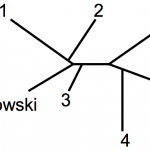hepatitis
Image of Indian Flying Fox from Wikipedia, Fritz Geller-Grimm
An ambititous project seeks to identify all unknown viruses in mammals to determine the relative risk of infection to humans and to develop strategies to prevent and treat infections before they become pandemics. The pioneering research team is led by Dr. Simon Anthony at Columbia University and Dr. Peter Daszak from EcoHealth Alliance.
The team started by looking for viral infections in the Indian flying fox (Pteropus giganteus), a species with pathogens known to transfer to humans (Nipah and Hendra viruses). Over five…
I know I give physicians crap sometimes on my blag, but I really do appreciate what they--along with nurses, physical and respiratory therapists, and other health professionals-- do.
They interact with people when they are at their 'worst'-- a normally cheerful, charming person is sick, scared, in pain, frustrated, worried, hurt, angry, drugged up when they are at the hospital. They are not themselves. And when patients are in this 'altered' state, they are helpless, relying on these professionals for help. I dont just mean 'helpless' in the sense most of us have no idea how…
Novel treatment and treatment stratagies for Hepatitis C infection is something I have written about on ERV a couple of times before:
New Hepatitis C treatment, maybe!
New Hepatitis C treatment, again, maybe!
To briefly summarize, Hepatitis C sucks. It has infected lots of people. It kills lots of people. And we have extremely limited treatment options for infected patients. We basically have two drugs, and they make you feel like shit, literally, for the 6-12 month treatment course. To operationally define "shit"-- Its like having the flu for 6-12 months, with the added bonus of '…
Steve Schoenbaum writes: In his blog this week, Mark Pendergrast challenges someone/anyone to take on explaining the differences between case-control studies vs. cohort studies. As an EIS officer, back in late May/early June 1968, I did a case-control study as part of the investigation of a common source outbreak of hepatitis in Ogemaw County, Michigan, so I will try to pick up the challenge. I believe it was only the second time case-control methods were used in a CDC epidemic investigation. In using this method I learned about the power of comparison, not just that numerators need…
Steve Schoenbaum writes: In his blog this week, Mark Pendergrast challenges someone/anyone to take on explaining the differences between case-control studies vs. cohort studies. As an EIS officer, back in late May/early June 1968, I did a case-control study as part of the investigation of a common source outbreak of hepatitis in Ogemaw County, Michigan, so I will try to pick up the challenge. I believe it was only the second time case-control methods were used in a CDC epidemic investigation. In using this method I learned about the power of comparison, not just that numerators need…
Karen Starko writes: When the "financial crisis" started and the news media started throwing around numbers in the trillions and projected fixes in the billions, I realized I just didn't get it. So I got a little yellow post-it, labeled it "understanding trillions," and started a list of examples. And when I learned that the US GDP in 2006 was 13T and the derivative market, estimated in June 2007, was valued at 500T, I quickly got a sense of the potential drain of the derivative market (in which money is spent on items without real value...my definition, please correct me if I am wrong). I…
Liz Borkowski writes: Mark Pendergrast wrote yesterday about how politics plays into the work of the EIS, and it's something that I kept noticing as I read Inside the Outbreaks. As he points out, my post last week highlighted the solution to the Reye's Syndrome puzzle - which was solved by Karen Starko, who's also one of the Book Club bloggers! - but didn't get into the larger issue: there can be a big difference between solving the puzzle and solving the problem. In yesterday's post, Mark writes:
Although Karen's and subsequent CDC studies clearly demonstrated that giving children aspirin…
Mark Pendergrast writes: To kick off this book club discussion of Inside the Outbreaks, I thought I would explain briefly how I came to write the book and then suggest some possible topics for discussion.
The origin of the book goes back to an email I got in 2004 from my old high school and college friend, Andy Vernon, who wrote that I should consider writing the history of the EIS. I emailed back to say that I was honored, but what was the EIS? I had never heard of it. I knew Andy worked on tuberculosis at the CDC, but I didn't know that he had been a state-based EIS officer from 1978…
Via ProMED Mail comes a news report that about 2,000 people in 5 states are being sought by health departments so they can be checked for hepatitis B infection. The potential source: the Mission of Mercy Dental Clinic, a free dental-care fair held just about a year ago in Berkeley County in the far north-east corner of West Virginia. The potentially infected include 1,137 people who were treated at the two-day clinic and 826 of the volunteers who worked there, from West Virginia, Washington, D.C., Virginia, Maryland, Pennsylvania and North Carolina. Three patients and two volunteers have…

